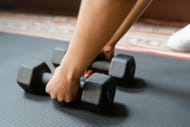Shoulder exercises for rehabilitation after injury typically start with mobility exercises and progress to isometric or static shoulder exercises, before including dynamic exercises, and, finally, functional or sports-specific exercises.
The shoulder is a remarkable joint. It's a shallow ball-and-socket joint, so there's a lot of freedom of movement, and the muscles around it keep it stable. It frees us up to exert maximum force when pressing, pulling, or throwing.
However, shoulders inevitably get injured a lot. Sooner or later, your shoulder will start to complain if you've been lifting for any length of time. Injuries are common, and you will have to undergo rehabilitation in order to get your shoulder back to its complete fitness. Below, we will discuss some of the best shoulder rehab exercises you can do.

Shoulder Exercises for Rehabilitation after Injury
The following are some shoulder mobility exercises that you can do as part of your shoulder rehabilitation after going through an injury. You can also check out these home workouts for strong shoulders.
1) Pendulum Exercises
Pendulum shoulder exercises are fundamental to this routine and should be performed as soon as your pain recedes. With time, you can equip yourself with a pole or wand to further extend your reach. For this exercise, stand in an upright position, with your weight distributed evenly between both shoulders.
A back-and-forth motion can be started by shifting weight from one foot to the other while keeping the injured shoulder relaxed. Standing with your feet flat and shoulder-width apart, extra lateral motion can be achieved by shifting your weight from right to left.

2) Pole Exercises
When performing wand exercises, you will have to use a long pole, such as a broomstick, to rehabilitate an injured arm. The injured arm is not used for propulsion, but is rather allowed to relax while going through its range of motion.
Do not put any additional strain on the injured arm by steering with it. You should mimic the bending, twisting, turning, extending, and bending at the waist and the shoulders.
3) Top Shoulder Stretch
To stretch the top of the shoulder, place a rolled-up towel under the bent elbow. The opposite hand inwardly pulls on the elbow. The purpose of this exercise is to improve the range of motion in the superior capsule and the resulting shoulder extension.
Roll up a towel and put it between your arm and your side. You will begin with the elbow bend, and bring it in towards the body by using the opposite hand.

4) Dynamic Shoulder Exercises
Shoulder rehabilitation typically entails a lot of dynamic, motion-based exercises. In most cases, you can start them as soon as the pain permits, though you should verify with your therapist or trainer to see which ones are best for your particular injury.
Shoulder dislocations and impingement syndromes require rehabilitation that includes strengthening the muscles responsible for medial or internal rotation. Resistance bands and dumbbell weights can be used for a variety of exercises, such as lateral and medial rotations, chest press, and others.
5) External Rotation
This is a great shoulder exercise to strengthen the external rotators for overhead stability. This move will also relieve stress from the rotator cuff.
Bands or cables should be placed between the shoulders and the level of the eyes to avoid inducing internal shoulder rotation. Keep your scapula retracted for the duration of the action. Your elbows should be pointing in the same direction as your shoulders at all times. Make sure your arms are in a straight line with or behind your ears as you rotate to press.

6) Wobble Board Exercises
Shoulder exercises for stability can be done with a wobble board for rehabilitation. The scapular muscles and abdominal stabilizers can both benefit from this multi-purpose piece of equipment.
The first step is for you to place your hands on the wobble board with your shoulders apart. Start with your knees for a simpler version of this exercise, and work your way up to your toes. You will perform circular movements on the board while staying perfectly balanced.
You can try out this exercise with a Swiss Ball. Since the shoulder is responsible for maintaining balance during this plyometric movement, it places a significant strain on the shoulder and the upper-body muscles.
You can do this by sitting on the ball with your hips and placing your hands on a wobble board. You will make an effort to stay upright while simultaneously using your arms in a variety of motions. A more advanced variation involves bringing the ball closer to the hips.
Perform the above-mentioned shoulder exercises under the guidance of a coach to fully repair and heal your injured shoulder. Meanwhile, check out these shoulder exercises for flexibility and strength.
Keep in mind that this information is not meant to replace the advice of a medical professional or physical therapist, nor is it meant to serve as a diagnosis of the nature or severity of a shoulder injury.
Whether you're trying to recover from an injury or living with unexplained shoulder pain, these exercises can help you build strength in the shoulder joint. While these shoulder exercises may not be the most impressive-looking movements, they will help your shoulders immensely in the long run.
